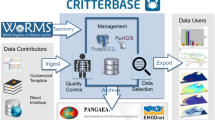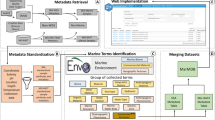Abstract
Increasing scientific information promote scientists to collect scattered data, put them together and organize them, and make them accessible with the best usability. These data include identification, characterization, habitats and biogeographical distribution, as well as their genomic information. Much of such data are now integrated so as to be accessible for scientists as databases, which are enormously useful to study marine biology. Here we describe some biographic databases and genome/transcriptome databases that are commonly accessed by scientists.
Access this chapter
Tax calculation will be finalised at checkout
Purchases are for personal use only
Similar content being viewed by others
References
Carradec, Q., Pelletier, E., Da Silva, C., Alberti, A., Seeleuthner, Y., Blanc-Mathieu, R., et al. (2018). A global ocean atlas of eukaryotic genes. Nature Communications, 9, 373. https://doi.org/10.1038/s41467-017-02342-1.
Decker, C. J., & O’Dor, R. (2002). A census of marine life: Unknowable or just unknown? Oceanologica Acta, 25, 179–186.
Halpin, P. N., Read, A. J., Best, B. D., Hyrenbach, K. D., Fujioka, E., et al. (2006). OBIS-SEAMAP: Developing a biogeographic research data commons for the ecological studies of marine mammals, seabirds, and sea turtles. Marine Ecology Progress Series, 316, 239–246.
Inaba, K. (2015). Japanese marine biological stations: Preface to the special issue. Regional Studies in Marine Sciences., 2, 154–157.
Klemetsen, T., Raknes, I. A., Fu, J., Agafonov, A., Balasundaram, S. V., Tartari, G., et al. (2018). The MAR databases: Development and implementation of databases specific for marine metagenomics. Nucleic Acids Research, 46(D1), D692–D699.
Plaisance, L., Knowlton, N., Paulay, G., & Meyer, C. (2009). Reef-associated crustacean fauna: Biodiversity estimates using semi-quantitative sampling and DNA barcoding. Coral Reefs, 28, 977–986.
Author information
Authors and Affiliations
Corresponding author
Editor information
Editors and Affiliations
Rights and permissions
Copyright information
© 2020 Springer Nature Singapore Pte Ltd.
About this chapter
Cite this chapter
Tanaka, K., Inaba, K. (2020). Marine Data. In: Inaba, K., Hall-Spencer, J. (eds) Japanese Marine Life. Springer, Singapore. https://doi.org/10.1007/978-981-15-1326-8_29
Download citation
DOI: https://doi.org/10.1007/978-981-15-1326-8_29
Published:
Publisher Name: Springer, Singapore
Print ISBN: 978-981-15-1325-1
Online ISBN: 978-981-15-1326-8
eBook Packages: Biomedical and Life SciencesBiomedical and Life Sciences (R0)




